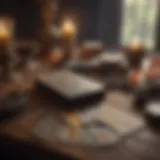Exploring the Depths of the Golden Dawn Tarot
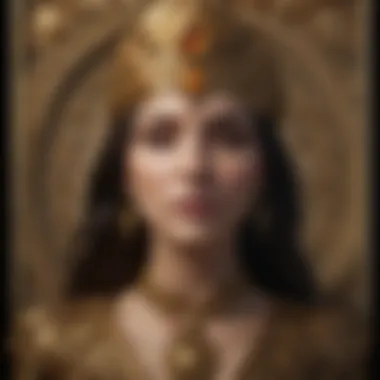

Intro
The Golden Dawn Tarot represents more than just a deck of cards; it encapsulates a rich tapestry of history, philosophy, and esoteric knowledge. Rooted in the magical and mystical practices established by the Hermetic Order of the Golden Dawn in the late 19th century, this tarot system is steeped in symbolism and meaning. The deck was designed to offer insights into both the inner workings of human psyche and the outer workings of the universe itself.
Historically, the Golden Dawn Tarot is intertwined with a host of ancient philosophies, including Kabbalah, astrology, and alchemy. Each card serves not only as a simple image but as a vase of multilayered meanings, connecting the mundane to the divine. Understanding this deck is like peeling an onion; each layer reveals more depth and complexity, relating back to broader esoteric traditions.
Within the framework of tarot, the Golden Dawn's approach offers practitioners tools not just for divination but for introspection and spiritual development. Among the key attributes of this system is its emphasis on the mastery of symbols, which lead to a more profound grasp of the tarot's core messages. As we delve deeper into this exploration, we’ll illuminate the pathways that weave through its history, practical application, and philosophical grounding.
Ranging from historical significance to the critical components of the tarot, we aim to provide an understanding that is approachable yet rich in detail. This investigation is not merely for seasoned astrologers or experienced tarologists; it is crafted for anyone willing to explore the intricate relationships between the cards, the cosmos, and human experience.
Historical Context of the Golden Dawn
Understanding the historical context behind the Golden Dawn is vital for grasping the significance of its tarot deck within broader esoteric traditions. This context acts as the backdrop against which the ideals, philosophies, and practices of the Golden Dawn emerged. The late 19th century, marked by a deep fascination with occult practices, saw a surge of interest in symbols, mysticism, and spiritual movements. This era was not merely about pursuing hidden knowledge; it represented an intentional link between ancient wisdom and modern thought. In particular, the Golden Dawn served as a crucible for these ideas, fostering a unique interpretation of tarot through various influences.
The Founding of the Golden Dawn Society
The inception of the Golden Dawn Society in 1887 in London stands as a pivotal moment in the realm of Western esotericism. Founded by William Wynn Westcott, Samuel R. Liddell Mathers, and others, this magical order sought to delve into spiritual transformation via ceremonial magic and mysticism. A sense of community and shared ideals was at the root of its formation. The founders emphasized the exploration of hidden truths through structured teachings, including a distinctive approach to tarot.
This group provided a supportive environment where the exploration of spirituality was encouraged, leading to significant developments in esoteric thought. Through meticulous rituals, members sought personal enlightenment and understanding of the universe. Without the foundational structures laid out by the Golden Dawn, the modern practices of tarot reading might have taken a very different path.
Influence of Victorian Occultism
The Golden Dawn was deeply enmeshed in the rich tapestry of Victorian occultism, a period characterized by a remarkable revival of interest in various mystical fields. During this time, numerous societies and groups sprung up, sharing a common goal of unraveling the mysteries of existence. This was not merely a whimsical pursuit, but rather an earnest quest for knowledge and spiritual growth.
Victorian sensibilities around spirituality and the arcane developed a particular aesthetic, blending art and mysticism. This contributed to how the Golden Dawn approached tarot. Elements of ritual, symbolism, and the overarching quest for truth formed a framework for interpreting tarot cards.
Many members of the Golden Dawn were also influenced by various religious movements of the time, including Theosophy and Rosicrucianism. These influences can be traced through the symbolism used in their tarot deck, as images and motifs reflect a synthesis of philosophies and beliefs prevalent in their society. The Golden Dawn did not operate in a vacuum; it drew from what was around it, crafting a deck that both acknowledged and expanded on the earlier traditions of tarot.
Key Figures in the Golden Dawn
The Golden Dawn was shaped by notable figures whose contributions crafted its identity and philosophy. Each played a unique role, blending esoteric knowledge with personal insights that would later become foundational in tarot practices.
A.E. Waite
A significant architect of the Golden Dawn tarot is Arthur Edward Waite. Known for his deep understanding of symbolism, Waite's contributions are critical in articulating the messages contained within the tarot deck. Waite’s most renowned work, the Rider-Waite tarot deck, emerged from his beliefs about the interconnectedness of imagery and meaning. He was not just a tarot creator; he was a philosopher who appreciated the narrative elements that tarot cards could convey.
His unique approach emphasizes the visual storytelling aspect that makes the deck accessible and meaningful, allowing users insight into their spiritual journeys. However, some critiques ensued regarding the usability of his images, as they often require deeper introspection which may deter beginners.
William Wynn Westcott
Westcott, one of the founding members of the Golden Dawn, brought a wealth of knowledge from his studies in the occult, kabbalistic teachings, and alchemy. His expertise in creating structured teachings provided a comprehensive framework for understanding the tarot’s intricate layers. Westcott's key characteristic lies in his ability to synthesize complex ideas into digestible concepts that members could explore.
His unique feature was an elaborate tarot correspondences scheme, where each card connected to various paths on the Kabbalistic Tree of Life. This system adds several layers of meaning but might overwhelm newcomers trying to grasp the basics of tarot reading.
Florence Farr
Florence Farr, another prominent member of the Golden Dawn, infused her theatrical background into her work with tarot. She understood the psychological aspects of imagery and its effect on the mind. Her contributions included the idea that tarot should engage emotionally as well as intellectually.
Farr's key characteristic was her emphasis on the performance aspect of ritual. She believed in the power of visualization and dramatization to illustrate the essence of each card. This conceptual approach is enriching but could be seen as eccentric by those preferring a more traditional interpretation of tarot.
"The partnership of various influences, philosophies, and personal insights provided a rich landscape for the interpretation of tarot within this unique framework."
By delving into these foundational elements, it's evident that the Golden Dawn is more than a simple tarot deck; it represents a confluence of history, mysticism, and individual exploration that continues to impact modern tarot practices. Understanding these influences can enhance interpretation and usage of the Golden Dawn tarot in personal and professional readings today.
The Creation of the Golden Dawn Tarot Deck
Creating the Golden Dawn Tarot deck marks a pivotal moment in tarot history. This deck was not just an artistic endeavor; it served as a framework for a deeper understanding of esoteric concepts and practices. The Golden Dawn's influence on tarot interpretation paved a new path for enthusiasts and practitioners alike, marrying the mystical with the practical. It invites tarot readers to explore a multi-layered approach to divination, raising the stakes beyond simple card reading to an exploration of inner truths and spiritual transformation.
Design Principles and Artistic Elements
The design of the Golden Dawn Tarot deck is steeped in intentionality. Every card is a window into a complex world of symbols and archetypes created for both aesthetic appeal and spiritual insight. While most tarot decks offer simple illustrations depicting their meanings, the Golden Dawn Tarot utilizes vibrant colors, intricate designs, and thoughtfully chosen imagery that aligns with elemental forces. The goal is not merely to convey information but to evoke a deep sense of connection with the material.
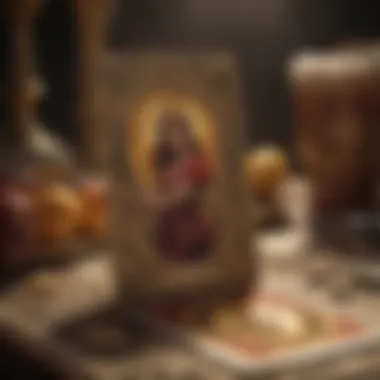

Additionally, the artist's choice of elements plays a significant role. For example, the use of gold leaf in some cards symbolizes the higher realms and divine wisdom, making the ordinary seem extraordinary. These artistic choices resonate with practitioners, creating a visual language that speaks directly to the intuition.
Symbolism and Imagery
Numerology
Numerology acts as a backbone for the Golden Dawn Tarot. The connection between numbers and universal principles provides practitioners with a methodological approach to tarot reading. Each card corresponds to a number, which contributes to its interpretation. For instance, the number three is often associated with creation and manifestation.
This association not only enriches the reading but also resonates with human experiences, making it all the more relevant. The use of numerology in the Golden Dawn Tarot is popular because it translates abstract concepts into practical insights, inviting deeper contemplation that can aid in personal growth.
Key Characteristics
- Connections between numbers and tarot cards.
- Provides a framework for interpreting cards.
- Promotes introspection and understanding of life events.
Benefits and Drawbacks
- Advantages: Enhances readings with added layers of meaning.
- Disadvantages: Requires some familiarity with numerology for effective use.
Astrology
Astrology plays a fundamental role in the Golden Dawn Tarot, weaving celestial influences into the fabric of card meanings. Each card's imagery often reflects astrological symbols or planets, making the reading more expansive. This makes the practice not merely about the cards but about tapping into the architecture of the universe itself.
For practitioners, understanding astrological associations can deepen insights. For instance, a card representing Venus might not only reflect love but also delve into aspects of beauty, art, and harmony. The inclusion of astrology as part of the tarot’s structure resonates well with those looking to build a comprehensive view of their circumstances.
Key Characteristics
- Aligns tarot with astrological principles.
- Expands meanings beyond immediate card interpretations.
Benefits and Drawbacks
- Advantages: Creates a bridge between terrestrial and celestial insights.
- Disadvantages: Might introduce complexity for those unfamiliar with astrology.
Kabbalah
The Kabbalistic tradition heavily influences the Golden Dawn Tarot, embedding mystical Jewish teachings into the deck's framework. Each card corresponds to a pathway on the Tree of Life, offering spiritual insights rooted in ancient wisdom. This aspect allows readers to explore complex relationships between concepts like the material and the spiritual.
Kabbalah’s distinct characteristics make this deck attractive for individuals interested in spiritual pathways. In seeking personal guidance, practitioners delve not just into tarot interpretations but also into their larger existential questions, enriching their readings in a manner that is both philosophical and transcendental.
Key Characteristics
- Ties tarot to Kabbalistic teachings.
- Encourages spiritual exploration beyond the cards.
Benefits and Drawbacks
- Advantages: Serves as a tool for profound spiritual understanding.
- Disadvantages: Requires knowledge of Kabbalistic concepts for practical application.
Adapting Traditional Tarot for the Golden Dawn
The adaptation of traditional tarot into the Golden Dawn framework showcases both innovation and reverence for tarot's historical roots. By incorporating elements like astrology, numerology, and Kabbalah, the Golden Dawn enriches existing tarot narratives while inviting a broader exploration of spiritual concepts. This transformation allows the tarot to evolve into a more layered tool offering guidance in both daily life and deeper spiritual contexts.
The combinations of these esoteric components result in a tarot system which invites readers to grasp not just the surface meaning of the cards, but to delve deep into the symbology, connections, and possibilities that lie in their interpretations. Thus, practitioners can savor both their immediate experiences and the broader cosmic narratives woven through their interactions with the cards.
Understanding the Structure of the Golden Dawn Tarot
Exploring the structure of the Golden Dawn Tarot is crucial for grasping its intricate symbolism and themes. Within this unique system, cards are arranged with a mathematical precision that reflects a deeper understanding of the universe and human experience. This framework not only sets the stage for tarot reading but enriches the intuitive process, allowing practitioners to delve beyond surface meanings. When one understands the underlying structure, the interpretations and insights gained from the cards become robust and multifaceted, enhancing their value in the hands of both novices and seasoned readers alike.
Major Arcana: Deep Symbolic Insights
The Major Arcana contains 22 cards, each depicting vital life journeys and archetypal experiences. These cards act as benchmarks of consciousness, guiding the reader through significant milestones. For instance, cards like The Fool and The Magician are more than mere representations; they embody profound spiritual concepts that resonate on psychological and emotional levels. Having a solid knowledge of these symbols cultivates a connection with the inner self, often revealing aspects that may remain hidden in everyday life.
Minor Arcana: The Four Suits
The Minor Arcana expands on the experiences depicted in the Major Arcana, divided into four suits. This division serves to categorize life's day-to-day interactions, emotions, and challenges into comprehensible sections, enhancing the reader's insight.
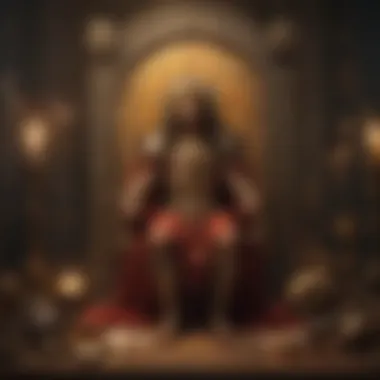

Cups
Focusing on the Cups, they represent the emotional and spiritual aspects of life. A key characteristic of Cups is their connection to feelings and relationships, symbolizing love, intuition, and emotional growth. Their fluid nature makes the information gleaned from these cards particularly rich for those seeking to understand their emotional landscape. One unique feature is how Cups often reflect the transition of emotions over time, allowing for deeper analysis of past, present, and potential future emotional states. Thus, readers find Cups advantageous for exploring relational dynamics and self-awareness.
Pentacles
Diving into the Pentacles, these cards are firmly grounded in the material realm. They represent aspects like finances, career, and health. Their key characteristic lies in the tangible and practical realms, appealing to readers interested in the logistics of life. Pentacles highlight stability and growth, making them a popular choice for those focused on personal success or achievements. A notable advantage is their clear connection to the physical world, which offers straightforward guidance on material affairs.
Swords
The Swords, meanwhile, delve into mental processes and conflicts. These cards are steeped in reasoning, challenges, and decisions. Their key allowing readers to confront uncomfortable truths or navigate dilemmas stands out. Readers often find Swords beneficial in understanding mental blockages or conflicts that need resolution. Moreover, they serve as reminders that clarity often emerges through struggles, making them complex yet rewarding components of any reading.
Wands
Turning to the Wands, they symbolize creativity, action, and passion. A defining characteristic of Wands is their association with energy and initiative; they urge individuals to pursue their desires and embrace their potential. The unique feature of this suit lies in its emphasis on movement and transformation. Readers who engage with Wands often gain insight into their aspirations, reminding them that taking bold steps is necessary to manifest their dreams. Therefore, Wands serve as an essential catalyst for energizing readings and motivating seekers to act.
Court Cards: Archetypal Representations
Finally, the Court Cards function as archetypes that embody different aspects of personality and behavior within the tarot narrative. They offer nuanced representations of various characteristics that exist within each of us. Whether it’s the nurturing figure of the Queen of Cups or the dynamic energy of the Knight of Wands, understanding these cards adds layers to interpretations, tapping into one’s inner wisdom. This complexity provides a pathway for readers to reflect on interpersonal dynamics and deeper motivations, serving as valuable guides in the tarot continuum.
Philosophical Foundations of the Golden Dawn Tarot
Understanding the philosophical foundations of the Golden Dawn Tarot sheds light on its profound influences and the depth of its interpretations. It's an intricate web, linking mysticism, psychology, and profound philosophical ideas. Each corner of this system curls back to classic traditions, bringing forth enlightenment for practitioners and enthusiasts alike. Recognizing how these philosophies shape tarot reading not only enriches one's experience but also cultivates a deeper respect for the esoteric nature of the cards.
The Hermetic Tradition
Rooted deeply in ancient wisdom, the Hermetic tradition serves as the backbone of the philosophies influencing the Golden Dawn Tarot. This tradition, named after Hermes Trismegistus, blends elements of Greek and Egyptian thought, suggesting that all truths are interconnected. The mantra "As above, so below" encapsulates this belief well, implying that the microcosm reflects larger cosmic truths.
In practical terms, this philosophy imbues each tarot card with multi-layered meanings that extend beyond the simple interpretations. Practitioners often find themselves tapping into this ancient wisdom, using the cards as a bridge between earthly experiences and celestial laws. By understanding that the cards mirror universal principles, tarot reading transforms from mere fortune-telling to a spiritual journey.
Alchemy and Spiritual Transformation
Alchemy is often misunderstood as a pursuit to turn lead into gold; however, at its core, it symbolizes the quest for spiritual purification and transformation. The Golden Dawn Tarot draws heavily from these alchemical concepts, suggesting that the act of reading the cards is akin to an inner transformation.
- Philosophical Gold: Within the selective symbols of the tarot lie paths to enlightenment. For instance, the Death card, often feared, actually signifies rebirth and renewal, paralleling the alchemical process of dissolution leading to purification.
- Diversity of Processes: Each suit in the tarot represents different alchemical processes—Cups relate to the element of Water and emotional transformation, while Swords engage with knowledge and intellectual separation. Thus, readers can navigate their spiritual evolution by interpreting the cards through this transformative lens.
This melding of alchemical thought with tarot practice promotes self-reflection, urging readers to confront their inner shadows and ultimately rise from them like the mythical Phoenix.
The Role of Rituals in Tarot Reading
Rituals are the beating heart of the Golden Dawn Tarot. They are more than just ceremonial acts; they create intentional space for connection with the divine and the subconscious. A ritual can range from setting the ambiance with candles and music to complex layouts that encompass astrology and numerology. All serve a purpose—to create a mindset conducive to deeper insight.
"The rituals serve as a key to unlock the hermetic secrets found within the soul, allowing the reader to contemplate not just the outer symbols but the inner meanings that resonate within."
- Establishing Sacred Space: Before diving into a reading, the act of creating a sacred space helps clear distractions and establishes focus. It's about entering a new dimension where mundane worries fade away.
- Ritual Layouts: Tarot spreads such as the Celtic Cross offer structured approaches, guiding readers through different layers of inquiry. Each position in a spread invites contemplation, turning chances into deep insights.
Applications of the Golden Dawn Tarot in Modern Practice
The Golden Dawn Tarot has made significant waves in tarot practices today, serving as a bridge between ancient wisdom and modern application. The essence of this tarot system lies not just in card reading but in the broader context of self-discovery, introspection, and spiritual growth. Practitioners utilize this deck for various purposes, each method providing unique benefits and insights.
Understanding how to apply the Golden Dawn Tarot allows users to navigate the intricate landscapes of their lives. This section aims to dissect specific techniques, layouts, and the fascinating synergy between astrology and tarot within this profound framework.
Interpreting the Cards: Techniques and Approaches
The act of interpreting Golden Dawn Tarot cards transcends mere fortune-telling. Each card is infused with layered meanings, drawing from a well of symbology rooted in hermetic philosophy. Practitioners often employ several approaches:
- Intuitive Reading: This involves tapping into one’s gut feelings regarding the card's imagery. It’s not just about memorizing meanings, but connecting on a personal level.
- Numerological Analysis: Given that the Golden Dawn Tarot was designed with numerology in mind, analyzing numbers associated with cards can provide additional context.
- Symbolic Resonance: Each symbol within the card has a deep significance that can resonate differently with the reader and the querent.
Techniques may vary, but the goal remains the same: to facilitate enlightenment and clarity.
The Tarot Spread: Commonly Used Layouts
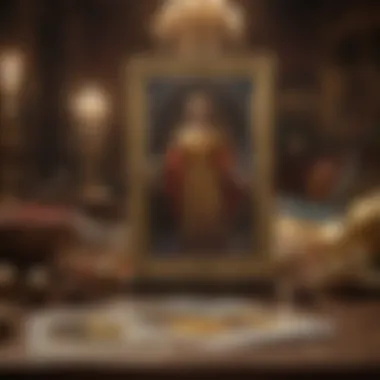

Celtic Cross
The Celtic Cross is perhaps one of the most widely recognized and popular tarot spreads in practice today. Its structure allows for comprehensive readings by covering various facets of a querent’s life. This spread includes:
- Ten distinct positions, each representing different aspects and influences.
- A layout pattern that balances both the present and potential future, offering a holistic perspective.
The diverse prompts of the Celtic Cross beckon deep introspection. This spread’s ability to tackle complex questions makes it a valuable choice. However, it can sometimes overwhelm beginners due to the sheer number of cards involved. While daunting, for those who grasp its intricacies, the rewards can be substantial.
Three-Card Spread
In contrast to the Celtic Cross, the Three-Card Spread is celebrated for its simplicity and direct approach. It often addresses:
- Past, Present, Future: This fundamental aspect reveals the timeline of the querent’s situation.
- Simple and quick interpretation, allowing for rapid insights.
The beauty of this spread lies in its versatility. Whether addressing broad themes or specific inquiries, it can adapt well to the practitioner’s needs. However, the abstract nature of only three cards may limit depth and could lead to oversimplified readings in more complex situations.
Integrating Astrology and Tarot for Deeper Insights
Understanding astrology alongside the Golden Dawn Tarot opens gateway to rich layers of interpretation. Each tarot card correlates with astrological symbols, creating a dual system of wisdom. By diving into planetary influences, practitioners deepen their insights:
- Astrological Associations: Each card corresponds to a planet or zodiac sign that enhances the reading.
- Timing and Cycles: Knowing astrological cycles can offer insights on when to act or expect changes. The interplay of tarot and astrology thus serves as a powerful tool of synchronicity and alignment.
Combining these elements encourages a broader lens on personal awareness and growth. Practitioners can discern patterns within their lives, guided by celestial movements.
The Golden Dawn Tarot doesn't just point the way; it illuminates the path, connecting the user to an intricate web of symbols, cycles, and insights.
Challenges and Critiques of the Golden Dawn Tarot
The complex tapestry of the Golden Dawn Tarot is not without its frayed edges. Examining the challenges and critiques that have arisen throughout its history is vital for a nuanced understanding of this esoteric system. The conversations surrounding authenticity, originality, and cultural appropriation invite practitioners and scholars alike to reflect critically on their practices and beliefs. Recognizing these debates not only enriches one's grasp of the Golden Dawn’s historical significance but also fosters a more respectful and informed approach to tarot reading in contemporary settings.
Debates on Authenticity and Originality
The quest for authenticity in the Golden Dawn Tarot brings forth a spectrum of opinions. Many practitioners argue that the original designs and principles set forth by the founders must be preserved to honor the integrity of the system. But, the discourse often juxtaposes these views against modern adaptations, which some feel dilute the depth and richness of the deck's symbolism.
Critics point out that certain elements of the Golden Dawn Tarot, such as those influenced by A.E. Waite's revisions, may lead to misunderstandings regarding the deck’s original messages. For instance, the incorporation of certain designs in Waite’s version deviates from the actual esoteric teachings of the Golden Dawn Society. This raises the question: should tarot remain static as it was in the 19th century, or can it evolve with time?
"A tarot deck that doesn’t evolve may as well be a museum piece, gathering dust rather than inspiration."
Those advocating for innovation suggest that adapting the Golden Dawn Tarot can open it up to younger generations, allowing them to connect with its profound teachings in more relatable contexts. Thus, the debate continues, straddled between preserving historical integrity and embracing modernity.
Cultural Appropriation in Tarot Practices
Cultural appropriation within tarot practices is another intriguing, yet contentious, facet of the Golden Dawn Tarot. As tarot's roots stretch across various cultures, the way one interacts with its symbols can lead to misunderstandings or misapplications. Some critics argue that certain elements within the Golden Dawn Tarot draw heavily from traditions that don’t necessarily align with its Western origins, potentially diluting their intended meanings.
This brings us to a pivotal consideration: are we, as practitioners, respecting the cultural origins of the symbols we employ? Even a simple image can carry profound significance in its native context, far removed from how it may be used in a contemporary reading. Practitioners should be aware of the histories behind the imagery and symbols in the Golden Dawn Tarot, approaching them with a lens of respect and acknowledgment, rather than appropriation.
Thus, discussions surrounding cultural appropriation encourage deeper examination of one’s approach to tarot reading. Adopting a respectful mindset not only enriches the reading experience but also honors the complexities of the diverse traditions that have influenced its evolution.
The Future of the Golden Dawn Tarot
As the tapestry of time weaves on, the Golden Dawn Tarot stands at a crossroads within the greater realm of tarot and esoteric practices. Its future is not just a continuation of its storied past but represents a dynamic evolution influenced by changing cultures and technologies. This section seeks to illuminate the potential paths the Golden Dawn Tarot may take, highlighting the importance of adaptability and interpretation within this ancient system.
Evolving Interpretations in Contemporary Society
In today’s fast-paced world, the Golden Dawn Tarot faces the challenge of remaining relevant amid a plethora of new tarot decks and spiritual approaches. Many modern practitioners gravitate towards the visually striking and often simplified versions of tarot. However, the rich symbolism and elaborate structure of the Golden Dawn Tarot provide a deep well of wisdom that can enhance contemporary practices.
One significant aspect is how practitioners infuse personal experiences and beliefs into their interpretations. Tarologists are constantly finding new layers of meaning in the already complex imagery of the Golden Dawn Tarot. For instance, combining traditional meanings with modern psychological concepts can yield fresh insights that resonate with present-day dilemmas. Practitioners may use the Major Arcana to explore issues of identity or personal development, while the Minor Arcana can reflect everyday stresses and joys.
The resurgence of interest in spirituality and introspection — fueled by societal upheavals and the search for meaning — has opened the doors for the Golden Dawn Tarot as a tool for self-exploration. Workshops and online groups are emerging, where enthusiasts gather to share their insights, ensuring that this deck's rich history is kept alive.
The Digital Age and Tarot Accessibility
With the advent of technology, the way we interact with the Golden Dawn Tarot is transforming. Digital applications and websites offer tarot readings that were once exclusive to face-to-face encounters. While some purists might view this trend with skepticism, it's hard to deny the advantages that digital mediums offer.
- Wide Reach: People around the globe can now access the Golden Dawn Tarot, which democratizes its teachings and invites diverse interpretations.
- Interactive Learning: Online platforms provide tutorials and forums where users can ask questions and share insights. This type of collaboration enriches understanding and creates a vibrant community of tarot enthusiasts.
- Personalization: Digital tools allow tailor-made experiences, meaning practitioners can adapt tarot readings to their unique situations anytime, anywhere. Mobile apps can help maintain connections to this mystical practice on-the-go.
“The internet is the new agora, a place where tarot readers, esotericists, and seekers converge to unlock the secrets of the Golden Dawn Tarot.”
However, as accessibility expands, challenges emerge. The depth of study required to truly appreciate the Golden Dawn Tarot often gets lost in simplistic gimmicks found in many tarot apps. Thus, it’s crucial for modern practitioners to resist the urge to merely skim the surface and continue to honor the depth and complexity inherent in this system.
